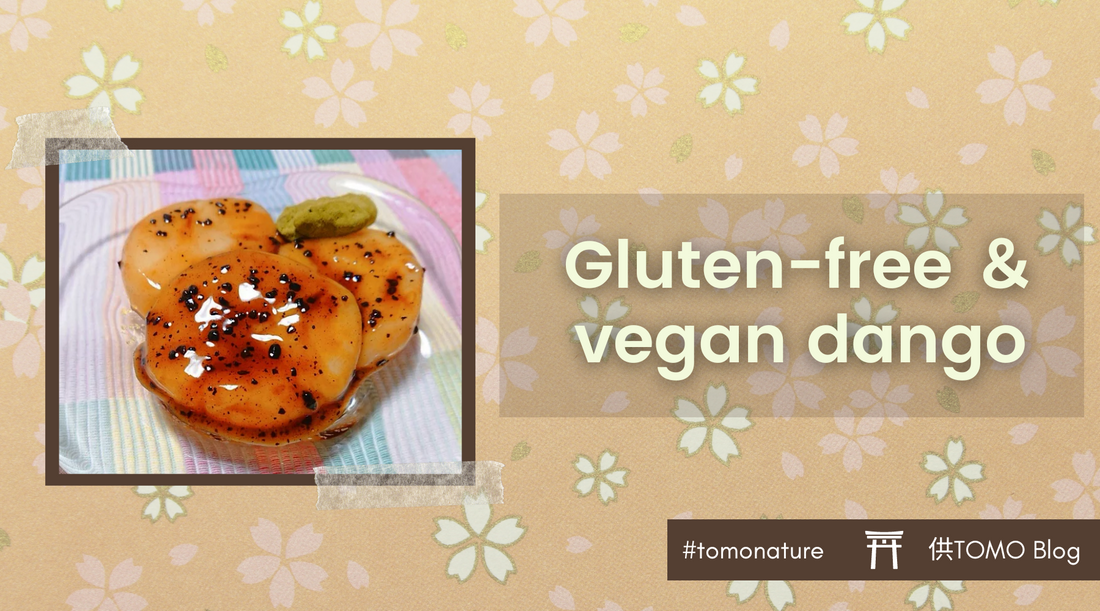
What is Dango?
Dango is a Japanese dumpling made from rice, usually enjoyed as a treat for dessert and during matsuri. They generally come in white, green, or pink, which are the 3 colors of the popular Hanami dango. Dango is usually served skewered on a stick.
Where Does Mitarashi Dango Come From?
Mitarashi dango are said to have originated in the late Kamakura period (1185-1333), when they were made in the shape of water bubbles in the Mitarashi pond at Shimogamo Shrine in Kyoto. At that time, soy sauce was spread on daigo, but in the Taisho period (1912-1926), the owner of the Kamo Mitarashi Tea House adjacent to Shimogamo Shrine created a sauce made of brown sugar and soy sauce, which became the current form.
Dango used as an offering in Shimogamo Shrine are made with 5 dumplings skewed to reproduce a body. The first dumpling would represent a head, the following two would represent the arms, and the two following would represent legs.
During the Edo period (1603-1868), the idiomatic expression “hana yori dango” (=literally “Dumplings rather than flowers”, which means to prefer substance over form) spread across the country and made this wagashi more and more popular.

How does Japanese Dango taste?
Dango has a chewy texture, a sweet taste, and they are filled with umami. Plain dango usually tastes like sweet rice.
What is the Best Pairing With Dango?
Dango goes well with TOMO Genshin brown rice coffee, and green tea.

Is Japanese dango gluten-free?
Dango made from refined rice flour is gluten-free.
And now, the recipe!
Recipe by Certified Japanese Dietitian Shimohata Minami
After obtaining a dietitian's license, she worked in the product development division of a food manufacturer. Following her husband's transfer, she left her job and she is now working as a freelance dietitian. She provides specific advice on health and nutrition, recipe creation, etc. She has one child.

Ingredients for delicious gluten-free and vegan Japanese dango:

“The white dango of this recipe have a delicious sticky texture and they are dipped in sweet soy sauce. This healthy Japanese recipe uses pure soy milk. You will love the amazing pairing of TOMO Genshin brown rice coffee and soy sauce. This dango recipe is simple, and ideal for sudden guests or as an everyday snack. Some Tanba black soybeans glacés with matcha are served on the side.
Ingredients for gluten-free and vegan dango dessert (2 servings)
Ingredients for dango dumplings:
70g of refined rice flour (also called “shirotamako”)
20ml hot water
45g of pure soy milk
15g of honey
Honey 15g
Ingredients for dango sauce:
5g of TOMO Café Genshin drip type (Japanese organic roasted brown rice coffee)
15ml of soy sauce
20g of honey
3g potato starch
15ml of water
How to make gluten-free and vegan dango
How to make delicious dango:
Add refined rice flour to a bowl, add hot water, and mix
Add soy milk and honey a little at a time, knead well, divide into 8 equal portions, and roll into flat balls.
Boil water in a pan, add the rolled white dumplings, and boil.
When the dumplings rise to the surface, take them out of the water and let them cool.
How to make a savory dango sauce:
Prepare a frying pan, add the ingredients, and heat
Stir well. When the mixture comes to a boil and starts thickening, turn off the heat and add the white dumplings.

Serve your gluten-free and vegan dango in a bowl, and it is done!
Suggestions for a toothsome dango experience:
In summer, let your dango cool and serve them as a topping with some ice cream
This recipe is low-sugar. Feel free to adjust the sweetness to your liking by adding more honey or sugar.
Click here to buy TOMO Café Genshin (Japanese brown rice coffee)
Discover more flavorsome and healthy Japanese recipes:
Japanese vegan brown rice coffee jelly recipe by French cook Alex from Umami and Vegan
Easy and healthy Japanese self-care drink: Honey Genshin latte
Easy Japanese Recipe: Genshin Brown Rice Coffee & Shimeji Mushrooms Galette

